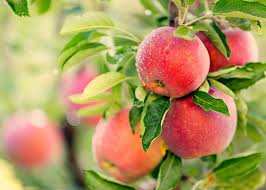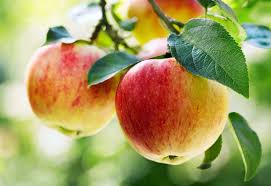Apples fruit which is scientifically known as Malus domestica are delicious fruits that come in various colors and flavors. They are widely loved for their sweet taste and crunchy texture. Apples are grown on apple trees, which are found in many parts of the world. These trees produce apples in different shapes and sizes, making each variety unique.
One of the most common types of apples is the red apple. It has a shiny, bright red skin and a juicy, sweet flesh inside. Another popular variety is the green apple, known for its tart taste and crisp bite. Apples can also be yellow or a combination of colors, adding to the diversity of this fruit.
Apples are not only tasty but also nutritious. They contain important vitamins and minerals that contribute to a healthy diet. Eating apples regularly can help support overall well-being. The fiber in apples is good for digestion, keeping the digestive system functioning smoothly.
In addition to being eaten fresh, apples are used in various culinary creations. They can be baked into pies, made into applesauce, or turned into refreshing juices. The versatility of apples makes them a favorite ingredient in both sweet and savory dishes. From salads to desserts, apples add a delightful touch to countless recipes.
Furthermore, apples have a rich cultural significance. They appear in many folktales, symbolizing different things across various cultures. The image of the tempting apple is often associated with stories and myths, creating a timeless connection between this fruit and human narratives.
Apples are also harvested during specific seasons, depending on the type. The fall season is commonly known for apple picking, where families visit orchards to gather fresh apples directly from the trees. This tradition has become a cherished autumnal activity for many.
Beyond their culinary and cultural importance, apples are often linked to health benefits. The saying “an apple a day keeps the doctor away” suggests that consuming apples regularly can contribute to maintaining good health. While this may be a simple saying, it reflects the belief in the nutritional value of apples.
In addition, apples are more than just tasty fruits – they are a versatile and integral part of our lives. From their delightful flavors to their cultural significance and health benefits, apples continue to be a beloved fruit enjoyed by people of all ages around the world. So, the next time you bite into a crisp, juicy apple, savor not only its sweetness but also the rich tapestry of history and tradition it carries.
Read Also: American Bullies: Description, Health, Origin and Complete Care Guide
History of Apples (Malus domestica)

Apples have a fascinating history that spans thousands of years. The origin of the domesticated apple can be traced back to ancient times, with evidence suggesting that apples were cultivated in the region of present-day Kazakhstan.
As human civilizations expanded, apples traveled along trade routes and were introduced to different parts of the world. The ancient Greeks and Romans embraced the apple, incorporating it into their culinary practices and mythology. The famous story of the Trojan War, where the Trojan prince Paris awarded a golden apple to Aphrodite, is one example of the fruit’s symbolic presence in ancient Greek mythology.
In medieval Europe, apples became a staple food and were commonly used in recipes. Monasteries played a significant role in preserving and cultivating apple varieties during this time. The spread of apples continued during the Age of Exploration, with European colonists bringing apple seeds to North America.
One pivotal figure in the history of apples is Johnny Appleseed, an American pioneer named John Chapman. In the early 19th century, Johnny Appleseed traveled across the American frontier, planting apple orchards and promoting apple cultivation. His efforts contributed to the widespread availability of apples in the United States.
The 20th century saw significant advancements in apple cultivation and breeding. Scientists developed new apple varieties with improved taste, texture, and resistance to diseases. The Red Delicious and Granny Smith apples, for instance, gained popularity during this time.
Today, apples are one of the most widely cultivated fruits globally. Orchards around the world produce a diverse range of apple varieties to meet the demand of consumers. The cultivation and breeding of apples continue to evolve, with ongoing efforts to enhance flavors, nutritional content, and sustainability practices.
The history of apples is a rich tapestry woven through the ages. From their humble origins in Central Asia to becoming a global fruit, apples have played a significant role in human culture, mythology, and agriculture. The journey of the apple is a testament to its enduring popularity and importance in various aspects of our lives.
Nutritional Value of Apple (Malus domestica)
Apples boast a range of nutritional values, making them a healthy and flavorful addition to one’s diet. Here’s a breakdown of the key nutrients found in apples:
1. Dietary Fiber: Apples are an excellent source of dietary fiber, particularly soluble fiber called pectin. Fiber aids in digestion, promotes a feeling of fullness, and helps regulate blood sugar levels.
2. Vitamins: Apples contain various vitamins, including vitamin C, which is essential for the immune system and skin health. Additionally, they provide small amounts of other vitamins like vitamin A, vitamin K, and some B-complex vitamins.
3. Minerals: Apples contain minerals such as potassium, which is vital for heart health and maintaining proper fluid balance in the body. They also contain small amounts of minerals like calcium, phosphorus, and magnesium.
4. Antioxidants: Apples are rich in antioxidants, including flavonoids and polyphenols. These compounds help neutralize harmful free radicals in the body, potentially reducing the risk of chronic diseases.
5. Low in Calories and Fat: Apples are naturally low in calories and fat, making them a healthy snack option. The combination of fiber and water content in apples contributes to a satisfying feeling of fullness without excessive calorie intake.
6. Natural Sugars: While apples do contain natural sugars, the fiber content helps regulate blood sugar levels, preventing rapid spikes. This makes apples a suitable choice for those managing their sugar intake.
7. Hydration: Apples have a high water content, contributing to hydration. Staying hydrated is essential for overall well-being and helps maintain various bodily functions.
Incorporating apples into your diet can provide a range of nutrients that contribute to overall health. Whether enjoyed as a whole fruit, sliced in salads, or used in various culinary creations, apples offer a delicious and nutritious option for individuals seeking a well-rounded diet.
Read Also: English Bulldog: Description, Health and Origin
Health Benefits of Apple (Malus domestica)

Apples offer several health benefits, making them a wholesome addition to your diet. Here are some of the key health benefits associated with consuming apples:
1. Heart Health: Apples are rich in soluble fiber, particularly pectin, which helps lower cholesterol levels. Regular consumption of apples may contribute to a healthier cardiovascular system, reducing the risk of heart diseases.
2. Weight Management: The combination of fiber and water content in apples contributes to a feeling of fullness, potentially aiding in weight management by promoting satiety and reducing overall calorie intake.
3. Digestive Health: The fiber in apples supports digestive health by preventing constipation and promoting regular bowel movements. It also promotes a healthy gut microbiome, which is essential for overall digestive well-being.
4. Blood Sugar Regulation: The fiber content in apples helps regulate blood sugar levels by slowing down the absorption of sugars. This can be beneficial for individuals managing diabetes or those looking to maintain stable blood sugar levels.
5. Rich in Antioxidants: Apples are a good source of antioxidants, including flavonoids and polyphenols. These compounds help neutralize free radicals in the body, potentially reducing the risk of chronic diseases and supporting overall health.
6. Hydration: With a high water content, apples contribute to hydration, which is crucial for various bodily functions. Proper hydration supports overall well-being, including skin health and kidney function.
7. Bone Health: Apples contain small amounts of minerals like calcium and phosphorus, contributing to bone health. While not a primary source, including apples as part of a balanced diet supports overall bone density and strength.
8. Immune System Support: The vitamin C content in apples plays a role in supporting the immune system. Regular consumption may help the body defend against infections and illnesses.
9. Dental Health: Chewing apples stimulates saliva production, which can help reduce the risk of tooth decay by neutralizing acids and maintaining oral health.
10. Cancer Prevention: Some studies suggest that the antioxidants in apples may have a protective effect against certain types of cancers. However, more research is needed to fully understand the extent of this potential benefit.
Incorporating apples into your diet as part of a balanced and varied eating plan can contribute to these health benefits, promoting overall well-being and supporting a healthy lifestyle.
How to Grow Apples ( Growing Guide)
Growing apples can be a rewarding experience, whether you have a spacious garden or a small balcony. Here’s a basic guide to help you grow apples successfully:
1. Selecting the Right Variety: Choose apple varieties that are well-suited to your climate. Different varieties have specific temperature and chill hour requirements.
2. Location: Plant your apple tree in a location that receives full sunlight. Apples thrive in well-drained soil with a slightly acidic to neutral pH.
3. Planting: Plant apple trees in late winter or early spring when the tree is still dormant. Dig a hole twice the diameter of the root ball and ensure the graft union is above the soil line.
4. Watering: Provide consistent watering, especially during dry spells. Newly planted trees need regular watering to establish their root systems.
5. Fertilizing: Use a balanced fertilizer in spring, just as new growth begins. Follow the recommended application rates on the fertilizer packaging.
6. Pruning: Prune your apple tree annually to shape it, remove dead or diseased branches, and improve air circulation. This helps prevent pest and disease issues.
7. Thinning: Thin out excess fruit when it’s about the size of a marble. This ensures larger, healthier apples and prevents branches from breaking due to the weight of too many fruits.
8. Pest Control: Keep an eye out for common pests like aphids, mites, and codling moths. Use organic or chemical controls as needed, and regularly inspect your tree for signs of infestation.
9. Disease Prevention: Apple trees are susceptible to diseases like apple scab and powdery mildew. Apply fungicides as a preventive measure and choose disease-resistant apple varieties if possible.
10. Harvesting: Apples are ready for harvest when they easily come off the tree with a gentle twist. Harvest times vary depending on the apple variety.
11. Storage: Store apples in a cool, dark place with good ventilation. Some apple varieties store better than others, so be aware of the storage life of the specific type you are growing.
12. Continuous Care: Monitor your apple tree regularly, check for signs of stress, and address any issues promptly. Consistent care contributes to a healthy and productive apple tree.
Remember that growing apples may require some patience, as it takes a few years for the tree to start producing significant fruit. Tailor your care routine to your specific apple variety and local climate for the best results.
Read Also: The Ultimate Guide to Choosing the Right Garbage Disposal Method
